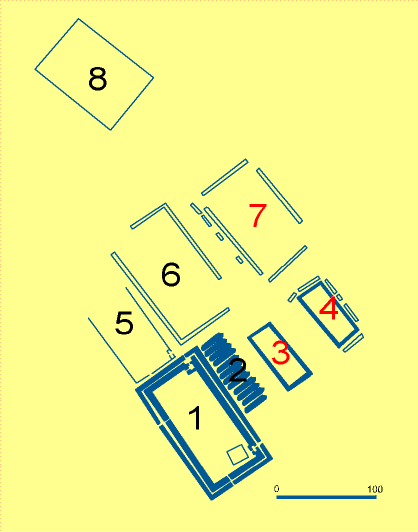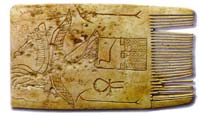BACK
Abydos Royal Enclosures, West of Kom es-Sultan
(Talbezirke, Funerary enclosures, Open Courts)
(Francesco Raffaele)

Click on the hot-spots (1, 2)
(Plan from Digital
Egypt website)

1 - Shunet ez-Zebib (Khasekhemwy)
2 - Mudbrick lined royal boats (12)
3 - Western Mastaba (Adjib or Semerkhet ?)
4 - Merneith (or Den ?) enclosure
5 - Middle Fort (Peribsen)
6 - Djer enclosure (only the row of subsidiary burials
is shown here)
7 - Djet enclosure (only parts of the two rows of subsidiary
burials are shown in this picture)
8 - Deir Sitt Damiana enclosure (incorporated
in the omonymous village; Qa'a ?)
_____________________________________________________
The Early Dynastic Royal Enclosures - Some notes
A) the general location
and orientation
B) the shape and conformation (architectural
features like niches pattern, entrances, flat perimetral bench, subsidiary
tombs, central mound, other inner/outer buildings, boats)
C) the finds
C1- relief decorations and inscriptions (on door-jambs
and other architectural elements of the Hierakonpolis 'Fort')
C2- other finds of ritual/funerary/cultual/ relevance,
eventual offerings, caches, deposits, vessels, pottery...
C3- mud seal impressions and other inscriptions
on/for storage commodities
D) Possible references to these monuments in contemporary (year-labels,
sealings, stone vessels) or later inscriptions and representations
(Annals, Pyramid texts, Myths, rituals, Heb Sed reliefs)
E) functional and structural similarities with earlier, contemporary
and later monuments
F) main purpose of the enclosures.
A) The site of the royal 'funerary' enclosures is located West
of Kom es-Sultan/ Khentyamentiw temple, in the low desert of Abydos
North, more than 1,5 Km north of the Early Dynastic royal cemetery
of Umm el-Qaab.
It consists of seven enclosures of which only the Shunet ez-Zebib
(Khasekhemwy's one, double walled and with some portions of the main
-inner- wall still standing at more than 10 m in height) and the Deir
Sitt Damiana (incorporated in the wall of the village and of the coptic
deir; perhaps dated to Qa'a) are still visible, owing to the more
massive thickness of their walls.
The main group of enclosures forms two rows of 3 rectangular monuments
each, roughly with the same NW orientation of the main axis.
In the southern row, from SW to NE: Shunet ez-Zebib, Western Mastaba,
Merneith's enclosure.
In the northern row, SW to NE: Middle Fort (Peribsen), Djer and Djet
enclosures.
North of this group, somewhat detached, the Deir Sitt Damiana wall
is oriented of some more degrees West than the six southern enclosures.
There would be many more aspects to be discussed, but this is not
the proper constest; I can only hint at three main points:
1) the possible relationship of the site of the enclosures with the
early temple of Khentyamentyw and, possibly, with the Early Dynastic
settlement of Abydos / This (cf. Kemp, in: MDAIK 23, 1968;
id., in: Antiquity 51, 1977). Perhaps this reflected a northward shift
of the urban center from the site of the early and middle Naqada town,
which would lie nearer to the site of the Cemetery U, B and the Umm
el-Qaab (?).
2) the practical and symbolical function of the walls in early
towns (B. Williams, Security and the problem of the
city in the Naqada period, in: P.Silverman, ed., 'For his Ka - Essays
in memory of K.Baer' 1994, 271-83) and especially in "preformal"
temples and royal funerary monuments (A. Jimenez-Serrano,
Royal Festivals..., 2002, with bibliography).
3) the possibility that the tradition of this monuments might
have been much earlier than the reign of Djer (as D. O'Connor, G.
Dreyer and S. Hendrickx have proposed in recent years). Perhaps already
in Naqada IIIA such structures were built, yet probably they were
paliçades of perishable materials which have left no trace.
B) It has been often stressed the similarity of the plan of
these enclosures with the hieroglyph Gardiner O6 (Hwt; cf.
P. Spencer, The Egyptian temple, 1984, 22-23, 43).
Early excavations (Ayrton and Peet) concentrated on the monuments
of Khasekhemwy and Peribsen: their main entrance is in the S part
of the E side, but a minor one also opens in the N (precisely NE)
corner. Later, F. Petrie (in 1922) evidenced the layout of subsidiary
tombs around the four eastern enclosures, but apart from some
later walls ('Mastaba') and burials in Merneith's monument and MK
chapels beside a late First Dynasty brick shrine W of Djer's one,
he failed to find the courses of the walls. Petrie published the objects
from the "tombs of the courtiers" (1925) and he found some evidence
of the practice of ritual human sacrifices in some of the pits around
Djer and Merneith. Djet's enclosure showed traces of a double line
of surrounding tombs.
A very important archaeological activity has been carried out by Yale/Pennsylvanya
Universities under the direction of D. O'Connor from mid 1980s to
mid 1990s. The sondages have evidenced the lower courses of Djer enclosure
wall, with a flat bench at its base (as those found by Emery in the
North Saqqara tombs S3504-7, early/mid first dynasty) perhaps also
to be adhorned with clay bulls' heads provided with true horns.
Thus even the early 1st Dynasty enclosures were already furnished
of a mudbrick wall, and not of perishable material paliçades as supposed
by Kaiser. Djer's enclosure parallels his Umm el-Qaab tomb (O) as
far as number of slain retainers: during his reign they exceed 500,
while the practice rapidly contracts in the middle-late 1st Dynasty,
to be completely abandoned after the last king, Qa'a.
Also the N entrance to Peribsen's enclosure has been cleared, similar
to the same one in the Shunet.
Some of the earlier enclosures had blocked entrances; a similar feature
was observed by Emery at N Saqqara (Sekhemkasedj's S3504, Nebitka's
S3038): he thought that these were temporary accesses to ease the
works and provisions of burial chamber and magazines.
Such a feature observed in the enclosures, could have a relevant meaning
with regards to the purpose of these structures. Khasekhemwy's "Fort"
at Hierakonpolis had yielded traces of building and pillars (granite)
within itself, and Lansing had also found architectural decorative
elements, namely granite jambs with foundation and other ceremonial
scenes (see Alexanian 1998); on the contrary the same king's Abydene
monument had, until recently, failed to reveal inner structures.
O'Connor's team found traces of a flat mudbrick coated mound
in the Shunet ez-Zebib, which appeared to precisely parallel the position
of the M1 initial mastaba of the Djoser complex at Saqqara at the
time of the original layout of the funerary complex. This fact enlightened
a clear pattern of development of the royal funerary monuments
in the Early Dynastic period, finally leading to the IIIrd Dyn Step
pyramid complexes and also demonstrating the ideological link of the
mastaba and pyramids remounting to the concept of the (mythical) primeval
mound.
Another important discovery by David O'Connor was the fleet of 14
boats found out of the E side of the Shunet ez-Zebib (yet probably
earlier in date than it). These were housed in mudbrick casing (white
washed) and probably poles/ pennants were inserted in this casing;
a boulder perhaps symbolized their anchors. The length of the structures
varied from nearly 20 to 27m. In one of the boats seal impressions
were found (no royal name, but Early First Dynasty in style) which
haven't been published yet.
C)
|

General bibliography
BOOKS (reports):
- Ayrton - Currelly - Loat, Abydos, Part III,
London, 1904
- T.E. Peet, The cemeteries of Abydos II, London, 1914
- W.M.F. Petrie, Tomb of the Courtiers and Oxyrhynkhos, BSAE, London, 1925
(this is now available on-line at Abzu/Etana: http://www.etana.org/abzu/
in pdf format)
ARTICLES:
- B.J.Kemp, Abydos and the Royal Tombs of the
First Dynasty, in: JEA 52, 1966, 13-22
- J.P. Lauer: Murs à redans encadrés par les "tombs of courtiers" et "forts"
d'Abydos, in: MDAIK 25, 1969, 79-84
- W. Kaiser: Zu den koniglichen Talbezirken der 1. und 2. Dynastie in Abydos
und zur Baugeschichte des Djoser Grabmals, in: MDAIK 25, 1969, 1-21
- W. Helck: Zu den "Talbezirken" in Abydos, in: MDAIK 28, 1972, 95-99
- W. Kaiser - G. Dreyer: Umm el-Qaab. Nachuntersuchungen im frühzeitlichen
Königsfriedhof. 2., in: MDAIK 38, 1982, 211-269
- D. O'Connor: The Earliest Pharaohs and the University Museum, in: Expedition
29:1, 1987, 27ff. (esp. p. 35-39)
- D. O'Connor: New Funerary Enclosures (Talbezirke) of the Early Dynastic
Period at Abydos, in: JARCE 26, 1989, 51-86
- D. O'Connor: Boat Graves and Pyramid Origins, in: Expedition 33:3, 1991,
5-17
- D. O'Connor: The Earliest Royal Boat Graves, in. E.A. 6, 1995, 3-7
- D. O'Connor: Abydos, Early Dynastic funerary enclosures, in: K. Bard (ed.),
Encyclopedia of the archaeology of Ancient Egypt, 1999, 93-95
- D. Sharp: Funerary Enclosures. Early Dynastic "Forts" Reexamined, in: KMT
12/1, 2001, 60-72
Summary of theories:
T.A.H. Wilkinson, Early Dynastic Egypt, London/New
York 1999 (2001 2nd ed) p. 238-240, 243-246 (Saqqara, Abydos and Hierakonpolis
encl.).
M. Lehner, The Complete Pyramids, 1997, 77.
R. Stadelmann, Die Ägyptischen Pyramiden, 1997, 13, 26ff.
A. Jiménez-Serrano, Royal Festivals in the Late Predynastic Period
and the First Dynasty, Oxford 2002, 31ff. (Review in March
2003)
Other Royal Enclosures:
For the Hierakonpolis "Fort"and related
bibliography also see http://www.hierakonpolis-online.org/
and the issues of Nekhen News 11, 1999, 14 and 12, 2000, 20f. available
on-line in the same website on Hierakonpolis (in Adobe Acrobat-PDF format).
For the decorations of the Hierakonpolis monument: N. Alexanian: Die reliefdekoration
des Chasechemui aus dem sogennante Fort in Hierakonpolis, in: N. Grimal (ed.)
‘Les criteres de datation stylistiques a l’Ancien Empire’, 1-21, Cairo 1998.
For the West Saqqara (stone masonry) enclosures see: Saqqara
(with large bibliography) and/or the Second Dynasty page introduction.
Also cf. Joris van Wetering, The Royal Cemetery of the Early Dynastic Period
at Saqqara and the Second Dynasty Royal Tombs, in: in K.M. Cialowicz, M. Chlodnicki,
S. Hendrickx & R. Friedman (eds.) Proceedings of the 'Origins of the State.
Predynastic and Early Dynastic Egypt', held at Krakow Aug-Sept 2002. Krakow,
in press (see the abstract of paper HERE);
id., internet pages in preparation at http://www.saqqara.nl
Francesco Raffaele (March, 4-7, 2003)
HOME


